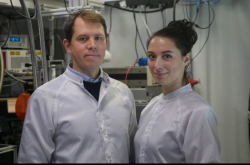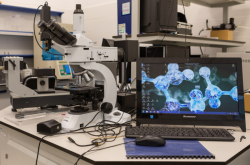The domain of theoretical physics
It’s often the case that the predictions of theoreticians get experimentally proved only decades later. According to Emil Akhmedov, DSc in physics and mathematics, head of the Department of Theoretical Physics at Moscow Institute of Physics and Technology, in recent years there haven’t been any unexpected experimental results, at least in fundamental physics. Everything observed now had been predicted in some way. However, this is not to say that you shouldn’t engage in theoretical physics. In 1874, Max Planck, the founder of quantum physics, then a first-year at the University of Munich, was told by his professor, Philipp von Jolly, that he shouldn’t study theoretical physics, “because everything in this field has already been discovered.” Since then, scientists have made a plethora of discoveries, some of which have changed the way we live our lives. Many natural phenomena have not been studied extensively. For instance, the chaotic nature of weather changes. And it will be the task of theoretical physicists to describe the laws of nature when enough observations have been accumulated.
Physicists can not only “see” into the future, but also study those regions of space that cannot be seen even through the most powerful telescopes. Based on their mathematical calculations, they create the models describing the earliest development of the universe. In this, the researchers aren’t limited by their labs or technologies – their limits lie in fundamental theories, their own minds, and the laws of nature.
The main goal of theoretical physicists is to see order in the surrounding chaos and to capture what they “see” and “understand” the language of mathematics. In other words, they strive to find mathematical descriptions of natural phenomena, to “fit” the laws of nature into mathematical models, and based on these, to predict new phenomena that humanity has yet to discover.

Credit: sakkmesterke / photogenica.ru
The most relevant issues
What are some current hot topics in theoretical physics? One of the main questions in the field is quantum technologies – namely, the challenge of developing a quantum computer.
“Many researchers from all over the world are working in the field today. Naturally, other fundamental and applied domains of physics are being developed, too. However, progress in these fields depends on the development of quantum computers. For instance, research in quantum gravity is connected to the analysis of quantum models, which is advanced by quantum computers,” says Alexey Fedorov, PhD in physics and mathematics, and the head of the Institute of Physics and Quantum Engineering at the National University of Science and Technology MISiS.

Alexey Fedorov. Photo courtesy of Redkollegia publishing house
In the context of quantum computer development, scientists often mention the concept of quantum computational advantage. This is the idea that no conventional computer can handle the volume and complexity of the computational tasks that a quantum computer is capable of performing. Theoretical physicists have already demonstrated the quantum computational advantage for abstract and text-related tasks. The next step is to demonstrate these advantages in solving practical problems.
Another relevant area of science is new materials. Researchers at ITMO are exploring the possibilities of creating and utilizing topological structures. These are a special type of artificial materials in which light scattering is minimized because of their defects or inhomogeneities. This property will make it possible to manufacture more energy-efficient and compact devices, while also minimizing the risk of energy loss due to design errors or poor-quality components.
New materials can also be created from “old” ones. More precisely, they can be formed from two or more components with different physical properties. The resulting substances are called metamaterials – new materials with unique characteristics that were not previously observed in any of their “ingredients.”
Theoretical physicists select the most suitable substances for creating such materials. They predict what characteristics these materials may possess and where they can be applied. As a result, practitioners will be able to work only with verified components of new materials, thereby reducing the time for research and the introduction of new products to the scientific market.
Among other pressing issues is the possibility of manipulating individual atoms within molecules. Is it possible to isolate a specific atom within a molecule? And what about extracting it? Or adding new atoms? Will it be possible to assemble new molecules from individual atoms in the laboratory? All these questions remain open.

Credit: Rost9 / photogenica.ru
Fundamental problems of theoretical physics
Research in contemporary theoretical physics focuses on three main questions: the cosmological constant, quark confinement, and quantum gravity.
-
The cosmological constant
This issue is probably related to the possibility of there being dark matter in the universe. The concept of cosmological constant was introduced by Einstein during the development of the theory of relativity. Back then, technologies weren’t capable of detecting the expansion of the universe, so it was considered to be static. This “property” of space was expressed as a constant that was also included in calculations at the time; eventually, it was considered to equal zero. However, already in the late 1990s, after a series of observations with powerful telescopes, it became evident that the universe’s expansion is accelerating rather than decelerating. This means that the cosmological constant doesn’t equal zero. This “invisible” substance is often referred to as dark matter. But what is its nature? How can its value be calculated? This are only a couple of questions faced by theoretical physicists.
Many hypotheses have emerged in relation to the question of the universe’s expansion. For example, one of the solutions proposed by theoretical physicists is that we are awaiting another Big Bang. It is hypothesized that one day the universe will expand to its limits and then collapse again.
“The Big Bang is a sharp exponential expansion with an extremely high rate in the exponent. However, due to dark energy, our universe is currently in an expanding phase, but with a very low rate in the exponent, which can be seen as a weak resemblance to the Big Bang. These processes can be compared to inflation in financial markets. Let’s say, it is around 3% annually, which is considered normal. If this rate sharply increases, for example, to 500%, hyperinflation occurs, a deviation from the norm. Essentially, the Big Bang was an expansion of the universe similar to hyperinflation: it expanded not within its normal limits, but drastically and on a very large scale,” explains Emil Akhmedov.

Emil Akhmedov. Photo courtesy of the subject
Another fundamental issue here is dark matter. Like dark energy, it cannot be seen through a telescope. However, dark matter begins to manifest itself on significantly smaller scales. Its influence can already be observed in the movement of stars within galaxies. Some scientists propose hypothetical axions as candidates for dark matter particles. However, these particles are yet to be discovered.
In 2023, physicists from ITMO University, in collaboration with Nobel laureate Professor Frank Wilczek, published a paper demonstrating that equations of electromagnetism in certain artificial media appear to account for axions being present in the medium. Therefore, even if axions do not exist, similar effects certainly occur in artificial media.
-
Quark confinement
This question concerns the formation of some of the smallest known particles of matter, quarks, and their interaction with other elements. The nucleus of an atom consists of protons and neutrons. They interact with each other through nuclear forces. When protons collide, energy is released, and a large number of new particles – hadrons, which consist of those very particles – quarks, are produced. They engage in all four fundamental interactions: electromagnetism, gravity, strong interaction, and weak interaction. However, there are still many questions regarding the peculiarities of their behavior. For instance, scientists do not have a fundamental explanation for why quarks do not exist separately, but only in groups within hadrons. How do quarks, which are almost free at very high energies, come together into a single whole at sufficiently low energies to form hadrons?
-
Quantum gravity
In simple terms, scientists are trying to describe exactly how gravity works in the universe. Currently, the explanation of interaction between material bodies that is provided by the theory of relativity leaves a lot of questions in terms of quantum mechanics. Physicists are trying to tie it all together. However, the problem is that these two theories (quantum and gravity) are based on conflicting principles. While quantum theory deals with very small objects, gravity theory deals with very big ones. A new theory will be able to answer many questions about the nature of the universe; it will also be a step closer to the so-called “theory of everything.”

Credit: sakkmesterke / photogenica.ru
The challenges of theoretical physics
Contemporary theoretical physics brings together many narrow fields. Researchers working in different domains sometimes have trouble understanding each other because they speak different “languages.” Moreover, it’s nigh impossible for one person to study the entire amount of data that has been accumulated up to this point. That’s why these days, unlike the times of Newton or Einstein, there are almost no scientists with encyclopedic knowledge, who can work in any domain.
Publishing results in modern science is also a long process. In order to see a paper published, researchers need to pass through several reviews. On the one hand, it makes science more exact, allowing for a well-rounded evaluation of the submitted work. On the other, it eventually adds a lot of bureaucracy and impedes progress.
“In this case, slow deliberation is another side of accuracy. We could publish papers without any reviews or verification, but then we would face an influx of bad-quality data. We wouldn’t have a filter for errors. For instance, this filter is absent in paid predatory journals that aim only to produce income. They can cause potentially false materials to appear in the information pool,” says Maxim Gorlach, PhD, a senior researcher at ITMO’s Faculty of Physics.

Maxim Gorlach. Photo by Dmitry Grigoryev / ITMO.NEWS
Another impediment for science is the focus on producing results “here and now.” As a result, says Maxim Gorlach, minor research tasks with predictable results are often prioritized over more ambitious projects with vague outcomes.
Thinking within classic theories also confines theoretical physicists. Many of the questions faced by science today contradict naive views on the world. For instance, why is space-time four-dimensional, and why is time different from space? There are no answers to these questions, but both experimental and theoretical physicists are often guided by these categories. That’s why many theoreticians believe that conventional fundamental theories need to be expanded and amended.
These contradictions will have to be resolved by scientists in the nearest future. And even though theoretical physicists have truly complex tasks in front of them and scientific development is impeded by many challenges, it is these scientists who will be the first to unravel the mysteries of the universe and understand the nature of our world.





